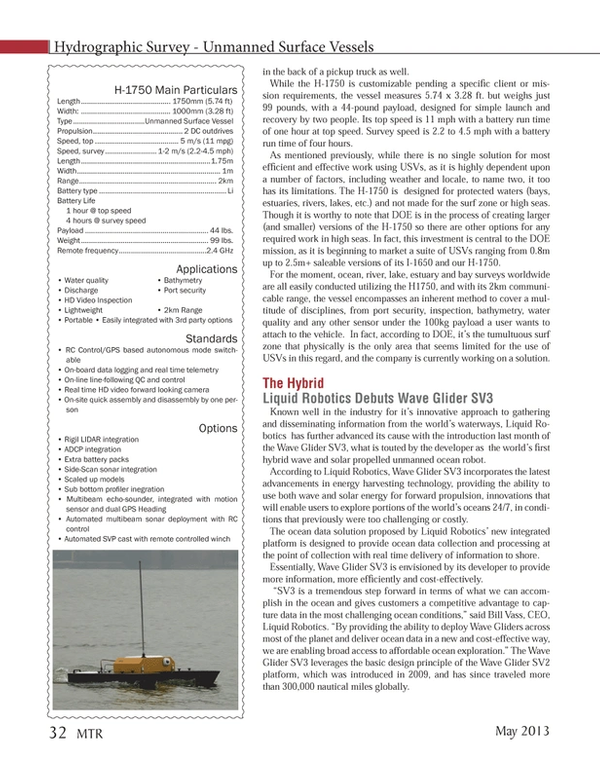
Unmanned Surface Vessels: Wave Glider SV3
Locked and Loaded for Hydrographic Missions
In recent years, the proliferation of unmanned surface vessels deployed for hydrographic missions has mushroomed as the collaborative effects of propulsion, software and sensor technologies has cumulatively made these vessels, large and small, more capable for a multitude of missions. In this edition, and on the heels of the Ocean Business exhibition last month in Southampton, Marine Technology Reporter examines recent developments.
The Hybrid
Liquid Robotics Debuts Wave Glider SV3
Known well in the industry for it’s innovative approach to gathering and disseminating information from the world’s waterways, Liquid Robotics has further advanced its cause with the introduction last month of the Wave Glider SV3, what is touted by the developer as the world’s first hybrid wave and solar propelled unmanned ocean robot.
According to Liquid Robotics, Wave Glider SV3 incorporates the latest advancements in energy harvesting technology, providing the ability to use both wave and solar energy for forward propulsion, innovations that will enable users to explore portions of the world’s oceans 24/7, in conditions that previously were too challenging or costly.
The ocean data solution proposed by Liquid Robotics’ new integrated platform is designed to provide ocean data collection and processing at the point of collection with real time delivery of information to shore.
Essentially, Wave Glider SV3 is envisioned by its developer to provide more information, more efficiently and cost-effectively.
“SV3 is a tremendous step forward in terms of what we can accomplish in the ocean and gives customers a competitive advantage to capture data in the most challenging ocean conditions,” said Bill Vass, CEO, Liquid Robotics. “By providing the ability to deploy Wave Gliders across most of the planet and deliver ocean data in a new and cost-effective way, we are enabling broad access to affordable ocean exploration.” The Wave Glider SV3 leverages the basic design principle of the Wave Glider SV2 platform, which was introduced in 2009, and has since traveled more than 300,000 nautical miles globally.
Wave Glider Main Particulars
Vehicle config
Sub and Float joined by 4m (13 ft.) tether
Dimensions Float: 114 x 26 in.
Sub: 8 x 75 in.
Wings: 56 in.
Weight 270 lb.
Water speed SS1: 1.0 knots
SS4: 1.7 knots
Depth rating Continuous wash and spray
Brief submergence to 6.5 ft.
Shipping Air freight compatible
Ships in two wooden crates (530 lb. total)
Power
Propulsion Mechanical conversion of
wave energy into forward thrust
Auxiliary thruster
Battery 980 Wh rechargeable Li-Ion standard
Increments (980 Wh) up to 7.84 kWh
Solar power 170W peak
Communications Iridium 9602
RUDICS (option)
Cellular (option)
802.11g WiFi
Max. payload weight 100 lb.
Max. payload volume 3.3 cu. mft.
Peak payload power 400W
(As published in the May 2013 edition of Marine Technologies - www.seadiscovery.com)
Read Unmanned Surface Vessels: Wave Glider SV3 in Pdf, Flash or Html5 edition of May 2013 Marine Technology
Other stories from May 2013 issue
Content
- What Goes Down ... page: 14
- MHI to Build for PGS page: 18
- Exploring the Abyss page: 20
- Unmanned Surface Vessels page: 24
- Unmanned Surface Vessels: Wave Glider SV3 page: 32
- Unmanned Surface Vessels: C-Stat Mobile Buoy USV System page: 34
- Ocean Business Sold page: 36
- Partrac, Rockland Scientific Announce Partnership page: 36
- Ashtead Increases Sonardyne 6G Rental Pool page: 36
- Seatronics Invests in Teledyne TSS Products page: 37
- Geomatrix Buys Applied Acoustics’ Energy Source page: 37
- New Gyro Changeover System page: 38
- Sonardyne Aids NOC page: 38
- EvoLogics Showcase Latest Developments page: 39
- Forum Subsea Rentals Adds iXBlue Systems page: 40
- DP-PHINS Adds to Acoustics page: 40
- Kongsberg to Offer AUV Rentals page: 41
- Fugro Upgrades DeepWorks page: 41
- Teledyne Moves Portfolio to Odom page: 42
- Ashtead Technology Launches Electric Dredge page: 42
- Navigation, Tide and Weather Information via Twitter page: 43


